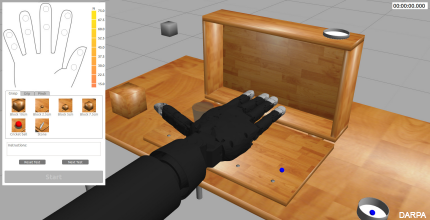DARPA developing a prosthetic hand with a sense of touch
The agency begins work on the HAPTIX program, which plans to add sensory perception to a dexterous artificial limb.

Participating teams will be able to test their designs using simulation software developed for DARPA’s Robotics Challenge.
It is amazing how far technology has come in the realm of prosthetics. Previous generations of prosthetics have provided artificial arms with some capability but have been limited in the dexterity and functionality required for everyday living. That could be changing, as the Defense Department’s research organization, the Defense Advanced Research Projects Agency, has blazed new trails in the last two years to help bring a greater range of motion to artificial limbs.
Most recently, DARPA has initiated contracts for Phase 1 in developing the HAPTIX prosthetic arm – the acronym stands for Hand Proprioception and Touch Interfaces and is a play on the word haptics referring to the sense of touch. The program aims to create a prosthetic limb that not only moves like a human hand but has a sense of fell, providing sensory information to the wearer’s brain. Previous generations of prosthetic limbs have not been able to simulate sensation. HAPTIX designers say they want to make their prosthetic limb so sensory-perceptive that amputees will want to wear it constantly.
So far, Phase 1 is simply testing and procuring a range of ideas. The best ideas will be further procured in Phase 2. DARPA seeks to integrate several commercial technologies within the HAPTIX model, such as electrodes found in cardiac pacemakers.
Simulation software will be provided to interested partners who wish to test and develop technology that will aid DARPA in its ultimate goal to “create a device that is safe, effective and reliable enough for use in everyday activities,” according to DARPA program manager Doug Weber. The agency is willing to help out interested vendors, offering them access to the simulator technology developed for the DARPA Robotics Challenge. This software was critical in the design for semi-autonomous systems used in emergency response situations.
HAPTIX isn’t the only breakthrough a DARPA program has achieved with prosthetic arms, one of several focus areas of military researchers working on to help soldiers who survived severe injuries from IEDs and other weapons. Those projects also could deliver benefits for the general population, too.
Last year, the Food and Drug Administration approved a first-of-its-kind robotic prosthetic capable of responding to muscle contractions, which provides amputees with unprecedented natural control and dexterity. The DEKA Arm System, developed by DEKA Research and Development under a DARPA program, is capable of 10 distinct movements with battery systems to protect against unintended movements. Nicknamed “Luke” after the Luke Skywalker character in “The Empire Strikes Back,” DEKA is equipped with electromyogram electrodes that received signals for muscle movement and can operate with wireless sensors to provide users with a sense of feel. DEKA can be outfitted for those who have lost limbs at the shoulder joint, mid-upper arm, or mid-lower arm, though not at the elbow or wrist joint.
Research agency also intends to apply for FDA approval for HAPTIX. “DARPA is partnering with scientists at the Food and Drug Administration to help develop standards for verifying safety and quantifying benefits of this new class of advanced technologies,” Weber said. “We hope to streamline the process of validating technologies that can help our military service members and veterans who have been injured while serving our country,”




